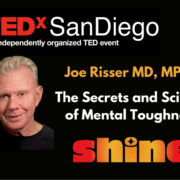The Secrets and Science of Mental Toughness from TEDx Talks
The Silent Crisis of Men’s Mental Health from TEDx Talks
“Our latest report reveals that while economic strain, social media overload, and healthcare gaps challenge mental well-being, community involvement and social connections support a stronger sense of belonging.
Key findings include:
-
Financial Stress and Mental Struggles: 42% of Canadians report a negative impact on their mental health due to economic conditions, the highest level recorded since MHRC began polling. Additionally, 39% of Canadians struggle to pay their bills.
-
Impact of News and Social Media: Social media’s impact is at an all-time high, with 33% reporting negative effects, and young adults spending more time online than ever before. More than four in ten Canadians (43%) say watching the news negatively affects their mental health, a 7% increase from Poll 22 in December 2022.
Additional major findings from Poll 23 include:
-
Community Participation and Mental Health: Canadians who participate in community groups feel a stronger sense of belonging, which is linked to improved mental health, while 62% of non-participants report feeling disconnected.
-
Healthcare Access Barriers: 19% of Canadians do not have a family doctor, with vulnerable groups—including racialized individuals, 2SLGBTQ+ communities, and those with financial challenges—facing the greatest barriers.
Read the FULL report
Read the ABRIDGED report
ABOUT THE STUDY
This study was conducted by Pollara Strategic Insights with an online sample of 4,050 adult Canadians between February 4 and 19, 2025. The results from this study provide insights into the mental health of Canadians and reveal concerning trends. Results from a probability sample of this size could be considered accurate to within ±1.5 percentage points, 19 times out of 20. Results have been weighted based on age, gender and region to be representative of the Canadian population.
A series of research briefs that provide an in-depth, specific investigation of our polling results can be found here. Results of earlier polls are compared when applicable.
Findings from our polls are searchable on our free Data Portal.”
Originally posted by Mental Health Research Canada
Have you ever said “I’m fine” when you were anything but fine? Or pushed through burnout or exhaustion because you didn’t want to seem weak? Have you ever kept parts of your identity hidden to feel safer or more accepted? If so, you’re probably masking.
Masking is when we hide or suppress something about ourselves — emotions, personality traits, behaviours, or symptoms — from others. It’s a coping mechanism used to protect one from judgment, stigma, or discrimination and might be done consciously or unconsciously.
Following a traumatic injury, Jess began masking as a coping mechanism with one goal: to get through the day feeling and seeming as “normal” as possible.
I was masking all the time in all areas of my life…
“…I recall in the weeks after the accident, I would try and go about life as regularly as possible: meeting up with friends after work, going for walks around my neighbourhood, etc., but was feeling the need to act like the person I was before it all happened… essentially pretending it hadn’t happened at all.”
Everyone wears a mask sometimes—at work, online, even with loved ones. But while it may help us get through the day, it can come at a deep personal cost. Suppressing emotions can increase stress, reduce self-esteem, and make it harder to seek help when it’s most needed.
It can also prevent others from truly seeing us—and supporting us. When we mask, we unintentionally teach people that we’re “fine,” even when we’re not. Over time, this can lead to feelings of isolation, disconnection, and burnout.
It was absolutely exhausting to be constantly acting like everything was business as usual.
“Directly following my traumatic injury, it was a really strange feeling, and absolutely exhausting, to be constantly acting like everything was business as usual when my physical injuries were still bandaged up and in a state of healing. Now, nearly six years after the injury, I still get startled by environmental triggers that remind me of the experience and feel the need to internalize those feelings in the moment to push through. Internalizing my feelings doesn’t usually feel good because I’m not honouring my needs in the moment, but sometimes that’s (unfortunately) what’s required to carry on with the day.”
Masking isn’t just an individual coping strategy—it’s a reflection of a society that still stigmatizes vulnerability. But we can change that. Every time someone shares their story, checks in on a friend, or opens up about how they’re really doing, they help create a culture where it’s safe to show up as we are.
How to support someone who masks
Practice active listening: Everyone unpacks at their own pace. Be patient, avoid pushing, and let them know you’re there whenever they’re ready to share. Sometimes the best support is simply being there. Avoid jumping to solutions and instead offer a listening ear: “I hear you. That sounds really tough. Do you want to talk more about it?”
Check in regularly: You don’t need a crisis to check in. A simple “Hey, how’s your headspace lately?” can go a long way.
Respect boundaries: Everyone unpacks at their own pace. Be patient, avoid pushing, and let them know you’re there whenever they’re ready to share.
Although it may be daunting, unmasking, when it’s safe to do so, can help people form deeper connections, increase self-esteem and reduce stigma, all of which supports good mental health.
When asked what advice she would give someone struggling with masking or who feels like they need to mask to be accepted, Jess says:
Find the people you can be fully authentic with and keep them close…
“…Appreciate them (thank them for being a safe space), and don’t take them for granted. And try to be that person for someone else who needs it, too. Being a support system for others can be mutually beneficial in moving towards acceptance.”
Originally posted by the Canadian Mental Health Association
The truth about mental illness: how to live with it from PsycHacks
Alcohol addiction, also known as alcohol use disorder (AUD), affects millions of people worldwide. A common question asked by individuals and families affected by AUD is whether alcohol addiction is hereditary. Research shows that both genetic predispositions and environmental factors play a role in the development of addiction.
Let’s dive into the science behind alcohol addiction, the influence of genetics, and how lifestyle and environmental factors contribute to this complex disorder.
What Is Alcohol Addiction?
Alcohol addiction, or alcohol use disorder, is a chronic condition characterized by the inability to control alcohol consumption despite negative consequences. Common signs of alcohol addiction include:
- Craving alcohol even when it causes problems.
- Difficulty limiting the amount of alcohol consumed.
- Physical withdrawal symptoms when not drinking.
The causes of alcohol addiction are multifaceted, with genetics being one of the contributing factors.
Is Alcohol Addiction Hereditary? The Role of Genetics
Studies suggest that genetics account for 40% to 60% of a person’s susceptibility to alcohol addiction. Specific genes influence how the body processes alcohol and how it impacts the brain’s reward system.
1. Genetic Variants and Alcohol Metabolism
- Certain genetic variants affect how quickly the body metabolizes alcohol. For example, some people inherit a gene that slows alcohol metabolism, leading to unpleasant effects like flushing and nausea, which can reduce the likelihood of heavy drinking.
- Conversely, those with genes that promote faster alcohol metabolism may drink more, increasing their risk of addiction.
2. Impact on the Brain’s Reward System
- Genes linked to dopamine regulation play a significant role in alcohol addiction. Alcohol stimulates the release of dopamine, a neurotransmitter associated with pleasure and reward. Genetic predispositions may heighten sensitivity to alcohol’s effects, making individuals more prone to addiction.
3. Family History of Alcohol Addiction
- A family history of AUD significantly increases an individual’s risk. Children of parents with alcohol addiction are approximately four times more likely to develop the disorder themselves.
Environmental Factors That Contribute to Alcohol Addiction
While genetics play a role, environmental factors are equally important in determining whether someone develops alcohol addiction.
1. Exposure to Alcohol in the Home
- Growing up in a household where alcohol use is normalized or excessive can shape attitudes toward drinking.
- Children of alcoholics may mimic behaviours they observe or turn to alcohol as a coping mechanism for family-related stress.
2. Stress and Trauma
- High levels of stress, trauma, or exposure to adverse life events can increase the likelihood of alcohol misuse.
- Individuals with genetic vulnerabilities may be more sensitive to these triggers, amplifying the risk.
3. Peer Influence
- Social environments that encourage heavy drinking can lead to addiction, particularly for those already genetically predisposed.
4. Mental Health Conditions
- Anxiety, depression, and other mental health conditions can contribute to alcohol addiction. Genetic predispositions to these conditions can further compound the risk.
Nature vs. Nurture: How Do They Interact?
The interplay between genetics (nature) and environment (nurture) is crucial in understanding alcohol addiction. While genetics may predispose an individual to alcohol use disorder, environmental factors often determine whether that predisposition manifests into addiction.
For example:
- Someone with a genetic predisposition but a supportive environment with limited access to alcohol may never develop AUD.
- Conversely, someone with no family history but a high-stress environment and frequent exposure to alcohol may still develop addiction.
Can Alcohol Addiction Be Prevented?
While genetics cannot be changed, understanding your family history and risk factors can help mitigate the likelihood of developing alcohol addiction.
1. Know Your Risk
If alcohol addiction runs in your family, be aware of your increased vulnerability. Limit alcohol consumption and adopt healthy coping mechanisms for stress.
2. Create a Supportive Environment
Surround yourself with people who support healthy lifestyle choices. Avoid environments where excessive drinking is encouraged.
3. Seek Professional Help for Mental Health Issues
Addressing underlying mental health conditions, such as anxiety or depression, can reduce the risk of self-medicating with alcohol.
4. Educate Yourself and Your Family
Open conversations about the risks of alcohol use and the role of genetics can help family members make informed choices.
Treatment Options for Alcohol Addiction
If you or a loved one is struggling with alcohol addiction, there are effective treatments available. Understanding the hereditary and environmental factors behind addiction can help guide recovery.
1. Behavioral Therapy
Cognitive Behavioral Therapy (CBT) and other evidence-based approaches help address the root causes of addiction and develop healthier coping mechanisms.
2. Medication-Assisted Treatment (MAT)
Medications like naltrexone and acamprosate can help reduce cravings and prevent relapse.
3. Support Groups
Groups like Alcoholics Anonymous (AA) offer a community of individuals who share similar experiences, providing encouragement and accountability.
4. Rehabilitation Programs
Comprehensive rehab programs provide a structured environment for detox, therapy, and long-term recovery planning.
FAQs About Alcohol Addiction and Heredity
- Can you inherit alcohol addiction from your parents?
While you can inherit a genetic predisposition, addiction itself is not directly inherited. Environmental factors play a significant role. - If alcohol addiction is hereditary, does that mean it’s inevitable?
No. While genetics increase the risk, lifestyle choices and a supportive environment can prevent addiction from developing. - Are there specific genes linked to alcohol addiction?
Yes, certain genes influence alcohol metabolism and the brain’s response to alcohol, affecting the likelihood of addiction. - Can someone without a family history of alcohol addiction still develop it?
Absolutely. Environmental factors like stress, trauma, and social influences can lead to addiction even in those without genetic predispositions. - How can I reduce my risk if I have a family history of alcohol addiction?
Limit alcohol consumption, seek healthy coping mechanisms for stress, and build a supportive social network.
Final Thoughts
Is alcohol addiction hereditary? The answer lies in the complex interaction between genetics and environmental factors. While genetic predispositions can increase the risk, they do not guarantee that someone will develop alcohol use disorder. Environmental influences, personal choices, and mental health also play critical roles in shaping an individual’s relationship with alcohol.
If alcohol addiction runs in your family or you’re concerned about your drinking habits, understanding these factors is the first step toward prevention or recovery. Seek professional help and surround yourself with a supportive community to manage your risks effectively.
Remember, alcohol addiction is a treatable condition. With the right approach, anyone can overcome the challenges of addiction and build a healthier future.
Originally posted by Addiction Rehab Toronto.
On January 10, Federal Minister of Health, The Honourable Mark Holland, issued a letter of interpretation on the Canada Health Act to the provinces and territories with new guidance and timelines for ending the practice of extra-billing patients for medically necessary services. The letter outlines how some medically necessary services, once delivered exclusively by physicians, are now provided by other health care professionals— such as nurse practitioners, midwives and pharmacists. The Minister’s letter states that Canadians can no longer be billed additional fees (known as extra-billing) to receive these publicly funded services.
By recognizing “physician-equivalent services,” CMHA believes that Minister Holland’s letter holds promise—and paves the way— for including mental health and substance use health services, like psychotherapy, counselling, and addictions services, in our publicly funded (free) healthcare system.
Across Canada, psychotherapists, psychologists, registered social workers and occupational therapists treat and support and diagnose people with mental health and substance use healthcare needs. In some cases, these professionals work alongside doctors on family health teams to ease the demand for care and provide expertise that improves health outcomes. The services they provide are “physician equivalent.”
The Minister’s letter acknowledges that health care has evolved since the Canada Health Act (the Act) was created in 1984, including the establishment of family health teams and the introduction of new regulated health professions, like registered nurse practitioners, who now deliver primary care equivalent to that of physicians. The delivery of mental health services has also changed significantly since 1984: the remaining asylums were downsized and closed; psychiatric hospitals were established; mental health in-patient services were further integrated into general hospitals; community mental health services were developed and expanded, and more provinces and territories created professional colleges to regulate psychologists, social workers and, in several provinces, psychotherapists.
Some regulated professionals currently deliver medically necessary services equivalent to those provided by physicians.
However, since the Canada Health Act was passed in 1984, public coverage for mental health and substance use health services has been guaranteed only if services are delivered by physicians or in hospitals and are considered “medically necessary” or “medically required.” This restriction means that many people who need lifesaving counselling or psychotherapy can only access it under certain conditions, or if they can afford to pay for it. Publicly funded services provided by the provinces and territories are limited, as are any employer-based insurance benefits that a person may have.
Canadians urgently need mental health and substance use health care. Every year in Canada, about 4,500 people die by suicide. In 2023, 8,538 people died from apparent opioid toxicity and two years prior, 3,875 lives were lost to harms from alcohol. Lives would be saved and so much suffering would be alleviated if people were able to get physician-equivalent treatment from registered social workers, psychologists, psychotherapists, and occupational therapists.
While family physicians are primary providers of mental health services—and bill public health insurance plans for mental health counselling (and psychotherapy)—many people in Canada have no access to one. If the Canada Health Act recognized physician-equivalent services provided by mental health professionals, it would be closer to delivering on its promise to “protect, promote and restore the physical and mental well-being of residents of Canada” and to ensuring that people in Canada have access to health services without financial barriers.
CMHA’s position is clear: The federal government must clearly extend its interpretation of the Canada Health Act to include mental health and substance use health services that are medically necessary, whether they are delivered by a physician or by another professional.
The federal government must also continue to modernize its health legislation and provide the provinces and territories with the resources necessary to ensure mental health and substance use health services are comprehensively covered under health insurance plans. It is only then that mental health and substance use health care will be universal.
Originally posted by the Canadian Mental Health Association
This Black History/Heritage Month we’re examining how the mental health experiences of Black people are unique. For Black people, the daily weight of racism1, discrimination2, and social injustice3 all factor into mental health—something many of us don’t even have to think about.
Dr. Regine King, a professor of social work at the University of Calgary, explains how social injustice and mental health are inextricably linked, with injustice creating “devastating mental health impacts.” 3
Social injustices and oppression are forms of violence, and violence is a traumatizing factor. Social injustices, overt or covert, impose a heavy weight and require a lot of physical, emotional, and psychological energy simply to endure them. Social injustices suck the life blood from individuals and families. They impact their self-worth, agency, self-confidence, and evaluation of their abilities. 3
— Dr. King
McMaster University Professor Ingrid Waldron, echoes this: “Racism is a significant structural determinant of health—one that has a very real, demonstrated impact on mental health and well-being, but historically hasn’t been taken seriously.”1
Data from a survey by the U.S. Centers for Disease Control and Prevention backed this up when it showed a more than 10 percent increase in clinical depression and anxiety among Black people following the murder of George Floyd in May 2020.3
Discrimination also contributes to persistent inequalities in access to mental health care for Black people, making discrimination a health issue. The shortage of culturally relevant supports and/or Black psychologists4 also create barriers to care. In fact, a recent study5 found that over 53 percent of Black participants experienced significant racism when interacting with healthcare professionals—the very people who are supposed to help.
That helps explain why depression is more prevalent among Black people—one study found that, rates of depression among Black people in Canada were six times higher5 than the rest of Canada’s population—but it doesn’t make it okay.
Thankfully, organizations across Canada are leading the way to more equitable mental health care for Black people, including:
But it shouldn’t just be up to Black people to fight racism and social injustice. People with privilege, White or otherwise, can help advocate for change to make mental health care access available to everyone, no matter who they are, when and where they need it. That’s CMHA’s vision: universal mental health care. If you want to help, sign up for updates and opportunities to take action as we work to push for system and social change, or make a donation to help us continue this important work. Together we can make a difference.
1 Laux, S. 2024. Ingrid Waldron explores how racism — past and present — affects Black mental health. McMaster University.
2 Mental Health Commission of Canada. 2021. Shining a light on mental health in Black communities.
3 Lavoie, S. 2021. How social justice and mental health interconnect. University of Calgary.
4 Brandow, C. & Swarbrick, M. 2021. Improving Black Mental Health: A Collective Call to Action. Psychiatric Services.
5 Liggins-Chambers, L. 2024. Resistance in the Black Community to Mental Health Services. Psychology Today.
6 Cénat, J. et al. 2021. Prevalence and Effects of Daily and Major Experiences of Racial Discrimination and Microaggressions among Black Individuals in Canada. Journal of Interpersonal Violence.
Originally posted by the Canadian Mental Health Association.
For those struggling with drug and alcohol addiction, there’s a temptation to give up cold turkey. But when is treatment necessary?
There’s a common misconception that if someone is addicted to drugs or alcohol, they simply lack the willpower to stop using. Those who have experienced substance use disorder firsthand know it’s much more complicated than that. What’s the difference between abstinence and recovery, and how are they related? Let’s dive in.
Understanding Abstinence & Recovery
Abstinence is the physical act of not using alcohol, drugs, or other substances. It is often a test of willpower and every day of abstaining from substance use should be viewed as a victory. Some people with mild symptoms of addiction or recreational users are able to simply stop. But for others with a serious addiction, abstinence is only one part of the recovery process. Abstinence alone doesn’t address underlying issues that come with addiction, such as trauma, PTSD, and other mental health issues. This is where recovery comes in.
Recovery is about more than just not using substances. There is a deeper healing that happens during treatment that leads to more profound, lasting changes in your life. Recovery is about taking your life back and experiencing the joy and fulfillment that comes from being substance-free. It involves treatment, constant reflection, building healthy habits, seeking new fulfilling relationships, and unlearning harmful coping strategies.
What’s the Difference Between Abstinence and Recovery?
Recovery is a lifelong process. Where abstinence can keep you sober, recovery gives you the tools to take your life back from addiction. But what gives recovery an edge in the fight against addiction over abstinence alone?
The key factor is their approach. Abstinence focuses on willpower and the your ability to simply fight the urge to use. Recovery goes about this differently. Its focus is on changing your life so being sober becomes a part of your being. It’s less about saying no to addiction and more about saying yes to a new way of life.
Without the deeper introspection and life-changing measures that recovery provides, a person may develop “dry drunk syndrome”. This happens when you abstain from substances but doesn’t address the root cause or co-occurring issues involved in your addiction. A 2023 study in the Journal of Substance Use shows us 29.8% of participants reported continuous abstinence from substance use or addictive behavior over a 5-year follow-up period. The risk of relapsing back into unhealthy behaviours is much higher without the changes recovery provides.
Recovery also encourages group therapy and surrounding yourself with a positive sober community, whereas abstinence is typically an individual undertaking.
How Do Abstinence and Recovery Work Together?
In the end, the objective of both abstinence and recovery is the same: to get back to a joyful life without substances. However, this is something that recovery prepares you for that abstinence alone can’t. Recovery seeks to provide the tools for sustainability so that you don’t rely on willpower alone to fight addiction.
Abstinence and recovery can work together and, without each other, healing can’t truly begin. Abstinence without recovery is painful and recovery without abstinence is impossible. When they work together, they are truly powerful.
Originally posted by Edgewood Health Network Canada.
Do you feel like your drinking may have gotten out of control? Have you been thinking that it might be time to quit drinking? Maybe you’re tired of feeling hungover. Perhaps you want to have more energy. Or maybe your loved ones are worried about you and you’re ready to choose a new path in life.
Whatever your motivation, there’s hope and help available if you’re struggling with an alcohol use disorder. Understanding how to quit drinking alcohol is the first step on your journey. Here are 14 helpful tips from EHN Canada that can help you quit or at least curb alcohol misuse as a first step. You will also find some FAQs about quitting drinking that can help on journey as well. .
1. Avoid temptation
Recognize and avoid situations where you’re tempted to drink. This means planning ahead for social events, vacations, and other circumstances where you’re used to drinking. Stay away from places and people who encourage you to drink more than you should. Keep an eye out for emotional triggers that make you want to drink, such as anger, stress, or loneliness. Once you identify these triggers, come up with alternative ways to cope with these feelings that don’t involve alcohol. For example, you might try going for a walk when stressed, calling a friend when lonely, or practicing deep breathing when angry.
2. Let others know you’re quitting
Sharing your decision to quit drinking can make your journey easier and more successful. Be open about your intentions with friends and family. Most people in your life will likely offer support and encouragement, which can be a big boost when you’re facing challenges. By talking about your decision, you might also discover friends who are considering quitting or who have already done so. These connections can be invaluable, providing you with understanding ears, practical advice, and motivation. Don’t be afraid to lean on your support network when you need it.
3. Choose a go-to non-alcoholic drink
When it comes to alcohol dependence, establishing good habits is the key to make any big change in your life. Try choosing a non-alcoholic drink that becomes your regular order. You might try sparkling water with lime, or spices in a hot drink such as tea or hot chocolate. If you have a standard drink for any circumstance, you’ll be less tempted to order that glass of wine.
4. Rediscover your hobbies or take up new ones.
Drinking (and recovering from a night of heavy drinking) can take up a lot of your free time. When you quit drinking, you may be surprised to find out how much more time you have suddenly. Now’s the time to take up a new hobby or to dive back in to something you miss. Maybe redesign your garden, catch up on your reading, work your way through a new video game, or volunteer for a cause that’s important to you. Plus, when you’re not bored, you have less incentive to drink.
As you explore new activities or rediscover old passions, you might also find that your energy levels and focus improve. This can lead to a positive cycle where your newfound interests not only fill the time you used to spend drinking but also contribute to your overall well-being. You might discover hidden talents, meet like-minded people, or simply enjoy the satisfaction of personal growth.
5. Delay drinking
If you’re trying to reduce the amount of alcohol you drink or to cut back gradually, one great tip is to push back the hour at which you have a drink. If you start to drink early in the day, you’re likely to keep drinking. If you decide that your first drink will be after dinner or once you’re done at the gym after work, you’re less likely to drink too much.
Another benefit of delaying your first drink is that it can help you build better habits over time. You might find that as you consistently push back your drinking time, you naturally start to drink less overall. This gradual approach can make the process of cutting back feel more manageable and less overwhelming.
6. Practice what you’ll say
When you quit drinking, people may want to know what’s going on — and some less helpful friends may urge you to drink even when you’ve said no. Having a few go-to phrases on hand to respond with in your social life can be useful. Try saying, “I’m cutting back for my health” or “I’m pacing myself” or “I feel better when I’m not drinking.” The more you use these phrases, the more you’ll reinforce your new, healthier habits.
In addition to these phrases, it can be helpful to prepare for more persistent questioning. You might consider responses like, “I appreciate your concern, but I’m comfortable with my choice” or “I’m exploring new ways to socialize without alcohol.” Remember, it’s okay to be firm in your decision. If someone continues to pressure you, it’s perfectly acceptable to change the subject or even step away from the conversation. Some people find it useful to have a trusted friend at social events who knows about their decision to quit drinking and can offer support or intervention if needed. The key is to feel confident in your choice and remember that you’re making a positive change for yourself.
7. Understand what to expect during withdrawal
If you’ve been drinking heavily on a regular basis, your body may have to detox when you quit drinking. You may experience irritability, anxiety, headaches, and sweating. All these symptoms are normal, and they should pass within about a week. Let your doctor know you’re going to be quitting drinking, and have a friend around to help you through the experience. If you experience any hallucinations or high blood pressure, call your doctor. See the FAQs below for more on this topic.
It’s important to remember that withdrawal symptoms can vary from person to person, and the severity often depends on factors like how long you’ve been drinking and how much you typically consume. Some people may experience milder symptoms, while others might face more challenging ones. During this time, it’s crucial to stay hydrated, eat nutritious meals, and get plenty of rest. Gentle exercise, like short walks, can also help manage symptoms and improve your mood. If you’re concerned about managing withdrawal on your own, consider seeking professional help. Many treatment centres offer medically supervised detox programs that can make the process safer and more comfortable. Remember, asking for help is a sign of strength, not weakness.
8. Set realistic goals
If you know you can’t quit drinking completely, then don’t make that you’re goal. If you plan to cut back on your drinking, set your goals ahead of time. Determine how many days you want to drink per week and how many drinks per day, and then cut those numbers down each week. Write your goals down to have stronger motivation to keep them.
As you work towards your goals, it’s important to track your progress and celebrate your successes, no matter how small they may seem. Consider using a mobile app or a simple journal to log your drinking habits and note the days you successfully stick to your plan. This can help you visualize your progress and identify any patterns or triggers. Remember, setbacks are a normal part of the process and don’t mean failure. If you slip up, treat it as a learning experience and get back on track. You might also find it helpful to reward yourself for reaching milestones – perhaps with a favorite non-alcoholic treat or an activity you enjoy.
9. Measure and count your drinks
If you count your drinks as you’re trying to reduce your intake, you’ll be better able to stick to your plan. Slip a note into your wallet to keep track, or record your drinks on your phone. Don’t give yourself wiggle room by ordering doubles. Knowing what you’re really drinking will help you meet your goals.
10. Get rid of the alcohol in your home
If you don’t have alcohol just waiting for you, you’re less likely to experience alcohol cravings — and that could cut down on your intake significantly. If you have roommates or family at home, ask them to work with you on this for at least a month. Then pour it all down the drain or give your alcohol away to friends.
11. Stock up on your non-alcoholic favorites
If you’re used to drinking at home, you don’t need to deprive yourself of having something cool and delicious in your hand. Stock up on interesting soft drinks, flavoured waters, juices and (soft) ciders so you always have something you like around when you’re thirsty. You might even want to try non-alcoholic wines and beers, if they don’t tempt you to go back to the real thing.
12. Plan alcohol-free days
One easy way to cut back on your drinking is to pick several days a week when you simply don’t drink. You can start with a couple of days, then add more a little at a time. Experiment with abstaining completely for a weekend or a week and see how you feel.
13. Keep a journal
Journalling can be a great way to track progress and work through your success. Even if you just jot down quick notes on your phone, keep track of all the good things that happen because you’re quitting drinking. Note down when you have more money in your pocket, when you have a great drink-free social outing, when you wake up feeling good, when your friends compliment your abstinence, and when you realize you’re losing weight. That list of notes will be a great encouragement going forward.
14. Seek support or treatment.
You’ll have an easier time quitting alcohol if you don’t try to do it on your own. That might mean joining a local Alcoholics Anonymous group, seeking out a therapist, or asking your doctor for a referral to alcohol rehab.
FAQs When You Decide to Quit Drinking
What happens to your body when you quit drinking?
If you’ve been drinking heavily, you may at first experience some withdrawal symptoms, including nausea, vomiting, shakiness and sweating. Soon, though, you’ll find yourself feeling healthier, sleeping better, and enjoying a clearer mind. Your heart and liver will start to heal, your blood pressure may drop, you may lose weight, and your sex life may improve.
How does quitting drinking affect weight loss?
Heavy drinkers and those who are overweight typically experience weight loss when they stop drinking. The weight loss effects for moderate drinkers are less pronounced.
Does quitting drinking ever get easier?
The first 2 to 4 weeks are the toughest for most people who quit drinking. After that, as your body recovers and heals, you’ll feel better continually and gradually. For many people, the 1-year mark is when they realize they have no cravings for alcohol.
Why should you quit drinking alcohol?
The answer to this one can be different for everyone. A reliance on alcohol can damage your body and your appearance. It can place in danger your own life and the lives of others. It can also damage your relationships. Quitting alcohol removes the cause of all this potential damage to your and your world.
Does your liver heal when you quit drinking?
Usually, yes. Your liver can begin to heal with a few weeks of your quitting drinking. Full healing can take months in the case of significant liver damage. For heavy drinkers with years of alcohol abuse in their past, in some cases, long-term liver damage is not reversible.
How long does depression last after quitting drinking?
Most people find their mood improves after 3 to 6 weeks of quitting drinking. If you don’t find an improvement in mood, see your doctor to explore whether you have an underlying mental health condition that needs treatment.
Is it possible to quit drinking on your own?
While for some people, yes, it is possible to quit drinking alone, but it’s very difficult to do. Even cutting back on alcohol use without support is hard to do, as alcohol is an addictive, habit-forming substance. You’ll find it easier to quit if you enlist help from a support group or a treatment program.
How can you sleep when you quit drinking?
Insomnia is one of the withdrawal symptoms you may experience when you quit drinking. By following a sleep schedule, practicing healthy sleep hygiene, and sticking to a bedtime routine, you should be able to move past insomnia. Other practices that can help reduce insomnia are meditation, progressive muscle relaxation, yoga, massage, aromatherapy, and biofeedback exercises.
How long does anxiety last after quitting drinking?
Anxiety is common immediately after you quit drinking. Expect your mood to improve within 3 to 6 weeks. If it doesn’t, see a doctor to check for any co-occurring mental health conditions.
How can I quit drinking when everyone around me drinks?
Be honest with your friends about your intention to quit drinking, and start your evening prepared by having a non-alcoholic drink already in your hand. Planning your responses for when people ask why you’re not drinking is helpful, and you may also want to have an exit strategy planned if the evening starts to get out of hand. Look for fun activities that don’t involve alcohol as well.
How can I quit drinking without stress?
If you’ve been coping with stress by drinking, you’ll have to find new ways to handle the stress that naturally comes with everyday life. Start exploring ways to destress before your quitting date. You might try reading a great book, taking a walk, pampering yourself with a long bath, or practicing yoga. In addition, learning calming methods of breathing can go a long way to helping you keep stress at bay.
What if I quit drinking alcohol, but I feel lost without it?
You can expect to feel all sorts of emotions when you first quit drinking alcohol. After all, you’re setting aside a habit (and potentially an addiction) that has been a big part of life, and you will feel a sense of loss. If, however, you still feel lost after a month or so, you should reach out for treatment options or a support group, if you haven’t already. Starting a support group or treatment as early as possible is one of the best things you can do in your quest to quit drinking.
Originally posted by Edgewood Health Network Canada.










